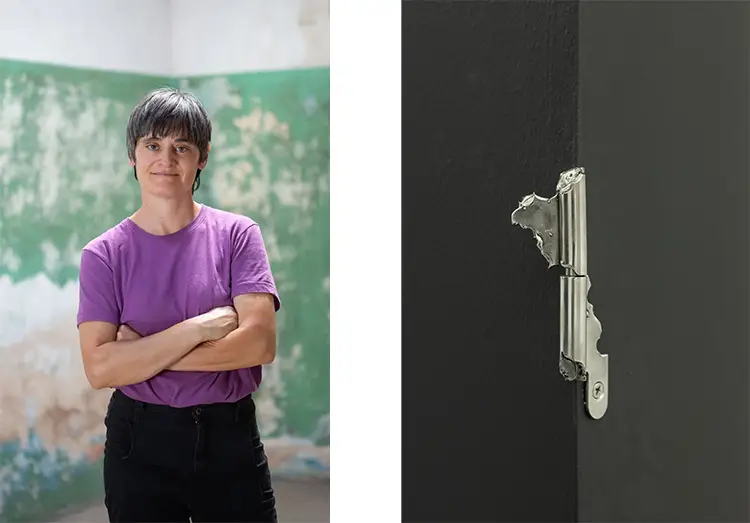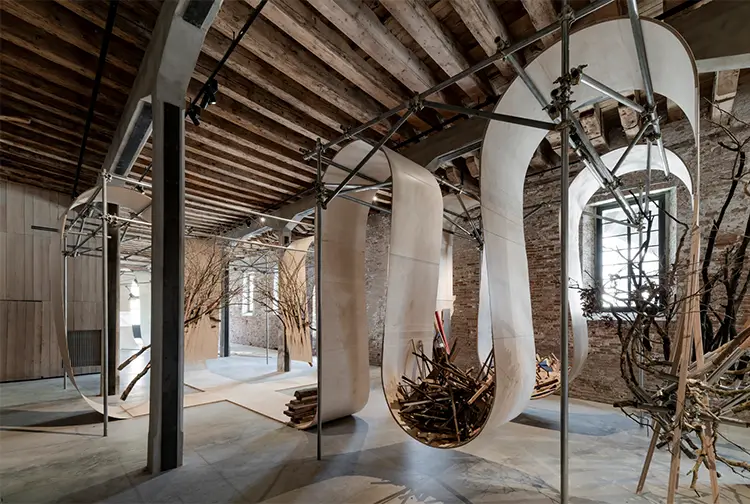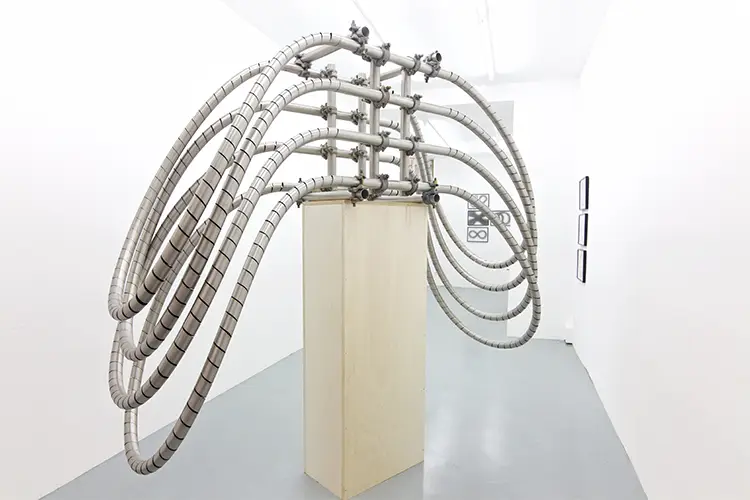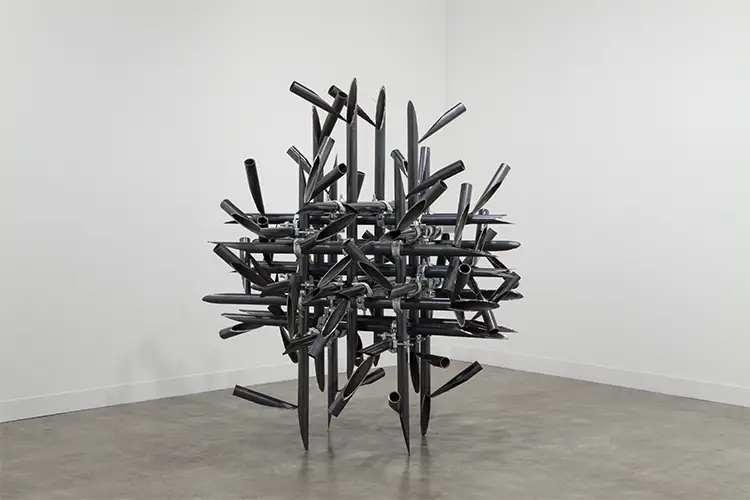Banner Image
One Frame Life, exhibition view | 2022 |
Galería Alberta Pane | Paris, France
Photo credit: Mami Kiyoshi
“The whole development of my work can be understood as a way of dealing with crises.”
A Force Shaped by Crisis and Material
Luciana Lamothe’s creative trajectory unfolds in dialogue with political upheaval, architectural tension, and the deeply visceral properties of matter. Born in Argentina in the early months of 1976, just before the onset of a brutal military dictatorship, Lamothe carries within her an ingrained sensitivity to the structural and emotional forces that define social experience. Her formative years, though personally marked by freedom, occurred under a climate of repression that imprinted itself across generations. This context, followed by Argentina’s severe economic collapse in 2001, infused her artistic inquiry with a persistent awareness of fragility, transformation, and resistance. Lamothe’s practice is not only situated in these moments of instability; it actively channels them, using matter as both a subject and vehicle for reflection on crises—personal, political, and material.
Her entry into the arts came through a shift in embodied expression. Initially drawn to athletics due to her natural physical aptitude, she transitioned as a teenager into sculpture, discovering a different yet equally dynamic relationship with physical energy. The connection between body and material became foundational in her work, setting the tone for a career that blurs the boundaries between the corporeal and the constructed. This early interaction with matter as both subject and collaborator sparked a fascination with form, energy, and endurance that continues to underpin her installations. Her sculpture is not a passive object; it becomes an event, a conversation between force and resistance, body and substance.
At the core of Lamothe’s artistic language lies a continuous exploration of how humans engage with materiality. Rather than aligning with traditional modernist reverence for the so-called truth of materials, her work questions and extends those principles. By stressing, warping, or pushing materials to their physical thresholds, she exposes their hidden possibilities. Her structures are simultaneously constructive and destructive, often inviting interaction that redefines the viewer’s position—from mere observer to full participant. In testing materials’ endurance, she invokes energy as transformation, introducing a sense of precarious equilibrium. This pursuit forms a thematic backbone across her series-based practice, where repeated gestures evolve in dialogue with varying mediums, from sculpture to video, drawing, and photography. Each contributes autonomously to a broader universe, unified by the pursuit of physical dialogue and shared vulnerability.

Artist Portrait
Photo credit: Lucia Bonells
Sin título
from the series A dentro | 2022
Stainless steel, 13 × 7 × 1 cm
Photo credit: Mami Kiyoshi
Luciana Lamothe: Material Confrontation and Collaborative Force
In Lamothe’s sculpture, confrontation and cooperation operate in tandem. Nowhere is this more poignantly embodied than in her work Prueba de Tensión, a walkable installation constructed from iron and wood that subtly shifts beneath the viewer’s steps. This precarious stability forces an encounter that heightens bodily awareness and invites trust. The visitor is no longer detached from the object but becomes part of an exchange—one that acknowledges mutual influence between the human form and the sculptural structure. The material responds to the body just as the body is subtly altered by the encounter. Through this exchange, Lamothe introduces what she calls “communion”: an egalitarian relationship between matter and being. The artwork becomes a shared space of transformation, challenging hierarchies and foregrounding the interdependence of all elements involved.
Her broader body of work continues to develop these themes through both formal experimentation and conceptual layering. The exhibition Ojalá se derrumben las puertas stands as a landmark in this regard, composed of four sculptures that destabilize conventional interactions between human bodies, infrastructure, and so-called natural elements. Through installations made of scaffolding and phenolic plywood, Lamothe reconfigures architectural logic. The structures expose internal mechanisms and reinterpret the language of construction, creating spaces that can be inhabited and traversed but not fully understood. This friction between familiarity and estrangement becomes a tool for unsettling static definitions—of material, of space, of human presence. By displaying the internal systems usually concealed within buildings, she invites a reconsideration of how we inhabit and relate to our surroundings.
The methodology behind this exhibition further reveals Lamothe’s commitment to relational construction. Many of the materials—wood fragments, metal joints, repurposed panels—were collected locally or salvaged from previous biennials, including the Argentina, Nordic, and German pavilions. These elements, tied to specific histories and processes of use and disposal, are woven into new forms that echo the cycles of extraction, consumption, and reuse. Lamothe’s approach to this reuse is what she refers to as “monomateriality,” a conceptual framework in which materials are no longer static but part of a living network of transformation. This tactile philosophy calls for deeper attention to not only the materials themselves but also to the systems of labor, ecology, and memory they carry with them. Her sculptures thus stand as both critique and proposition: they reveal the wounds of material history while gesturing toward the possibility of alternative, more reciprocal relationships with the world we construct.

Ojalá se derrumben las puertas | 2024
Wooden planks, branches, found wood, pipes, and scaffolding clamps
60ª Esposizione Internazionale d’Arte, La Biennale di Venezia
Photo credit: Matteo Losurdo
The Discipline of Undisciplined Space
Lamothe’s installations offer more than visual spectacle; they construct environments of resistance. Each piece occupies space in a way that rejects the rigid geometries and rationalist logic that defined modernist architecture. Instead, her curved scaffolding, intersecting planes, and tense joints introduce fluidity and contradiction. These structures carve out what might be called “undisciplined spaces,” where traditional norms of construction are subverted, and new spatial grammars emerge. Within these irregular architectures, bodies are invited to engage in new ways, navigating not through predefined routes but through the organic invitation of form. Such environments echo a kind of spatial insurgency, offering alternatives to the logic of control that underpins modern development and its colonial legacies.
Influenced by a wide range of stimuli—including music, urban infrastructure, and the tools of industrial construction—Lamothe’s work functions at the threshold of aesthetics and activism. Her sculptures resist finality, speaking instead to processes that are ongoing, fragile, and contingent. This is particularly evident in the care she takes in balancing violence and tenderness within her materials. The harsh cuts, exposed joints, and pressured bends evoke histories of coercion and survival, while the overall structure suggests shelter, support, and potential healing. These tensions are not resolved but rather made visible, demanding viewers confront the complexities embedded in material histories and spatial practices. Her installations, though solid in form, are always in conceptual flux, resisting closure and embracing uncertainty.
The affective charge in Lamothe’s environments stems not just from their physicality but from their political edge. By unmasking the architectural underpinnings of colonial and industrial power structures, her work challenges viewers to question the spaces they inhabit and the systems that built them. Curator Sofía Dourron, in her interpretation of Lamothe’s practice, draws on philosopher Malcom Ferdinand’s critique of “colonial inhabitation” to deepen this reading. Lamothe’s structures thus act as counter-sites—spaces where both human and non-human elements co-exist in modes of mutual acknowledgment rather than domination. These are not utopias but active sites of negotiation, where care is embedded within the very mechanisms of construction. The viewer, navigating the curves and counterbalances, becomes implicated in this reimagining of how we build, move, and exist in space.

Mutation | 2018 |
Galería Alberta Pane | Paris, France
Photo credit: Takeshi Sugiura
Luciana Lamothe: Sculpting a Future from the Remains
Lamothe’s practice is deeply grounded in process, repetition, and variation. Her commitment to working in series reflects a belief that a single gesture cannot exhaust an idea. Instead, each iteration becomes an opportunity to push the boundaries of concept and material further. This method allows her to maintain a dialogue between pieces, generating insights that emerge only through accumulated difference. Though each work stands on its own, the connections across series and mediums—whether sculpture, video, or drawing—construct an overarching system of inquiry. Each medium brings its own challenges and interpretive layers, but sculpture remains central due to its immediacy and physical intimacy. Its directness enables her to confront materials without translation, creating a visceral interaction between concept and form.
Her studio, too, is an extension of this philosophy. Maintaining an open yet organized space, Lamothe prioritizes clarity, focus, and minimalism. Inspired by Japanese aesthetics, she finds creative strength in the simplicity of her surroundings. Her workspace is both a site of production and a zone of conceptual incubation. Working with a close team of assistants, she navigates complex projects through collaboration while staying centered on her vision. Lamothe adapts her environment to eliminate digital distractions, such as temporarily removing social media from her phone, underscoring her commitment to attentiveness. These habits reveal an artist deeply invested in the conditions of making, where discipline and openness co-exist to enable innovation.
Despite her prolific output and international recognition, Lamothe continues to hold space for unrealized ideas. Her archive of unproduced projects—often limited by funding or scale—remains a wellspring of possibility. Some require expansive resources, while others are modest and awaiting the right moment. This reservoir of potential speaks not only to her ambition but also to her belief in the enduring relevance of unfulfilled thought. Through exhibitions across Europe, the Americas, and beyond, including presentations at Palais de Tokyo, Museo del Barrio, and the Lyon and Berlin Biennials, Lamothe has shared her evolving inquiries with global audiences. Her work continues to ask urgent questions about matter, power, and cohabitation, offering not only critique but also blueprints for other ways of building—and being—with the world.








